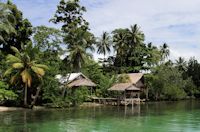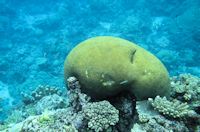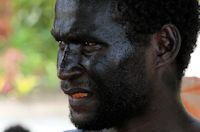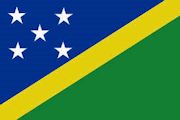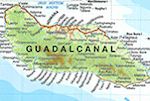Vilu
War Museum, Guadalcanal
Pictures
of Vilu War Museum
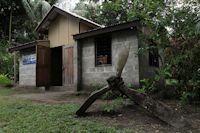 By
Richard Moore
By
Richard Moore
An
astounding labour of love sits about 50 kilometres west
of Honiara, hidden behind a deceptively plain-looking
building.
A
sign tells you that it is the Vilu War Museum, but it
looks very small to contain much in the way of World
War II treasures.
At
a clearly pre-arranged signal – the toot of our car
horn – a white-haired Solomon Islander emerges from
the surrounding green vegetation to let us in.
He is the curator and owner of the museum, Anderson
Diua, and it was his uncle, Fred Kona, who created the
place we are about to visit.
Inside
the concrete block and tin-roofed building are WWII
photos lining the rough walls.
Anderson
talks about the war and details of the pictures before
leading us outside to what proves to be the real museum.
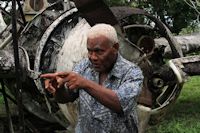 Immediately
you know you have stumbled upon something special in
this out-of-the-way spot.
Immediately
you know you have stumbled upon something special in
this out-of-the-way spot.
It
is an amazing collection of war relics that would make
a large-city museum proud – if they could fit them in.
Instantly a rusting Japanese 150mm artillery piece grabs
your eye, then you notice the two other heavy guns that
have been brought from the jungle to rest at Vilu. They
all sit neatly in a line on the well-looked after lawn
amid pretty gardens and tall trees.
Nearby the turret of an Allied tank lies forlornly wanting
attention, but that is instead grabbed by the nose cone
of a Japanese bomber known as a Betty.
More
aircraft remains sit in the peaceful garden urging you
on towards a burned Grumman Wildcat with a badly mangled
propellor. It clearly had a bad end to its last flight
and, with luck, the pilot survived.
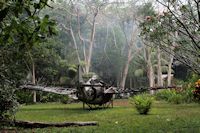 With
a cheeky look Anderson tells us to ready our cameras
and he removes a long metal pin from the wing. Then
he moves back towards the tail of the aircraft easily
swinging the wing backwards revealing the plane to be
a carrier-based fighter that could be folded up to fit
better below the warship’s flight deck.
With
a cheeky look Anderson tells us to ready our cameras
and he removes a long metal pin from the wing. Then
he moves back towards the tail of the aircraft easily
swinging the wing backwards revealing the plane to be
a carrier-based fighter that could be folded up to fit
better below the warship’s flight deck.
Then,
while carefully avoiding a squadron of bees, Anderson
shows us the early-war US military symbol of a white
star with a red circle in the centre.
That
identifier changed quickly, he said, as the red circle
was too similar to the infamous red disc of the Japanese
rising sun symbol.
There are many other great finds at Vilu War Museum,
including a long-barrelled anti-tank gun, and the radial
engine from a Zero – the famed Japanese fighter that
created havoc for Allied pilots.
 While
focusing on another aircraft’s remains I recognised
a piece of it that took me straight back to my childhood
and building model planes. It was the front landing
gear of a US fighter – a Lockheed P-38 Lightning to
be precise. Standing back the shape of the pilot’s cockpit
was unmistakable and was a sad end to one of the Allies
most feared weapons.
While
focusing on another aircraft’s remains I recognised
a piece of it that took me straight back to my childhood
and building model planes. It was the front landing
gear of a US fighter – a Lockheed P-38 Lightning to
be precise. Standing back the shape of the pilot’s cockpit
was unmistakable and was a sad end to one of the Allies
most feared weapons.
Another
easily recognisable form were the remains of a Vought
F4U Corsair, better known to the Japanese as the Whistling
Death because of its distinctive engine noise. It was
hard to miss the Corsair’s W-shaped wings and, having
seen the fighter fly at airshows in New Zealand, it
was a reminder of the violence of war and what happens
to a beautiful flying machine when it hits the ground.
Standing
quietly poignant in the museum grounds are memorials
to the fallen servicemen of both sides.
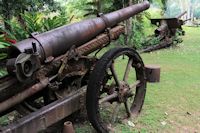 They
are in their own small place of peace amid the remains
of war.
They
are in their own small place of peace amid the remains
of war.
The
journey to Vilu War Museum from Honiara takes about
an hour and visitors with an interest in military history
should write it down as a must-visit attraction.
